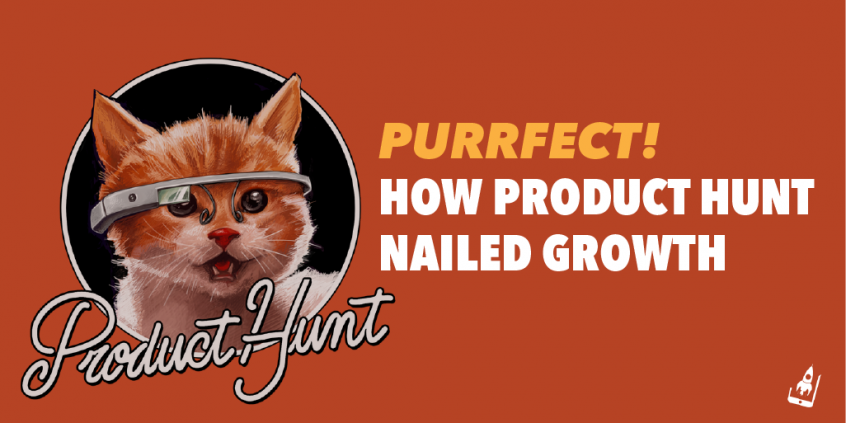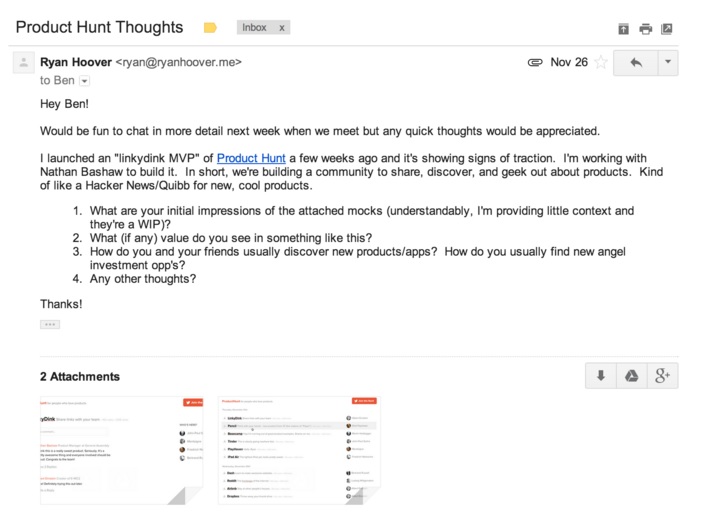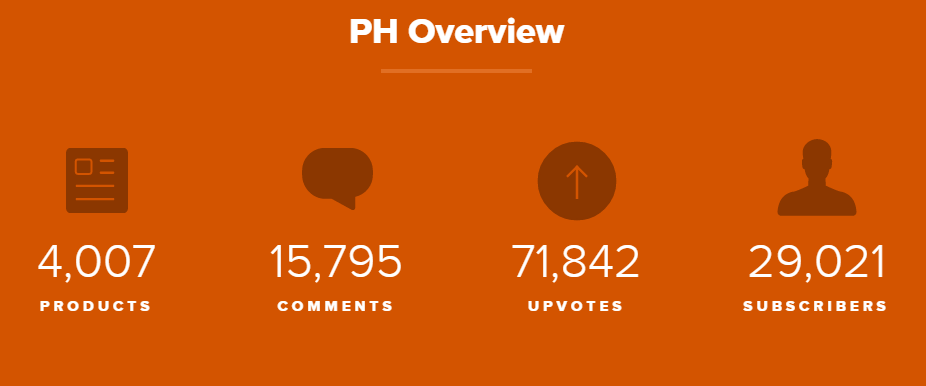We love cat memes, and we love Product Hunt, don’t we?
We all want our startups to scale, and learning from the success of others is a great way to begin. While it is naive to believe that one can recreate success by merely emulating the growth story of rising startups, it undoubtedly provides insights into strategies and techniques, which can be later customized and introduced into one’s own startup.
Product Hunt enjoys a massive patronage amongst the tech community and is a growth story that is truly remarkable.
In this article, we explore the rise and rise of Product Hunt and the lessons we all can learn from its exponential growth!
But we aren’t leaving you with just that. Kiki Schirr, the author of the first Product Hunt Manual, is providing our readers with a discount code for her latest version, out in a few days. Register for our newsletter by clicking on the banner below! The manual will be in your inbox in the first week of December!
Lesson 1: Solve A Basic Problem And Stay True To It
Ryan Hoover has stated in numerous articles that the idea of Product Hunt emerged from numerous discussions with his friends. Given his background, he was often commenting on the latest finds on tech dailies and social media. In an interview with First Round, Hoover said:
“ I wanted some sort of curation — a way to find all of the cool new things that the startup community would find interesting. There was no one place for these types of conversations.”
While Hoover may not have been able to gauge the success of such a curation at the start, he had at least provided an avenue for people to dabble.
Key takeaway:
Clearly it was all there, yet no one had attempted to create a repository that was readily accessible. Most startups aim at solving a simple problem, however, complicate the process behind it. It is, therefore, essential to stay true to the product and the journey forward.
Lesson 2: Make Your Product Bankable
The go to place for most tech enthusiasts was Hacker News, till Product Hunt gained mileage. Any new product takes time to be labelled “bankable” and once you have crossed that milestone, there’s no turning back. Being bankable isn’t easy, and it takes a while for a product to build that kind of trust amongst its users.
Daniel Kempe, who recently launched Quuu– a remarkable content curation tool (see it to believe it ) on Product Hunt said:
How did Product hunt achieve this status? There are a few factors that may explain this bit:
-
Targeting the best users at the beginning
The initial Product Hunt users were friends and business associates of Ryan Hoover. Given the fact that the startup ecosystem is extensively dependent on tools of all kinds, it wasn’t hard for him to push his business idea to them. In a descriptive post-Ryan, mentions that he reached out to people with his MVP at an early stage. He targeted people with a simple email asking for feedback by sharing early mockup of the product. He later proceeded with a series of Beta launches amongst a group that constituted entrepreneurs, founders, tech specialist and others.
Here’s a snapshot of an early email by Ryan:
Such a congregation of like-minded individuals is bound to release a canon of word-of-mouth and bountiful users to a startup’s doorstep. Product Hunt did all this through age old emails.
The early Product Hunt users also received a special status- a unique number and a thought leader status apart from the ability to comment.
In a nutshell, it was able to target and attract its most valuable users at the very start.
-
Offer Exclusivity
Human psychology works in interesting ways, especially when it centres around exclusivity. As individuals, it is hard for us to move away from an offer that is exclusive, (Think Amex Cards or that Premier Golf membership!). The same principle can be applied while marketing your next big product.
The Product Hunt journey displays a similar element of exclusivity in its approach. It can be seen in the way users were invited in the initial days to test the product. Even today it is an invite only platform with exclusive powers to hunters and moderators. This involves the ability to comment and DM.
Here’s a glimpse of their all timeleaderboard as of today!
Also a cat GIF! (Just checking that you are still reading this article)
Lesson 3: Growth Hacking Community Building
In an exciting post published on Forbes, Neil Patel, states that 90% of all startups fail. He goes on to say:
“ Growth — fast growth — is what entrepreneurs crave, investors need, and markets want. Rapid growth is the sign of a great idea in a hot market”.
Though there are various factors that work in tandem, growth hacking has emerged as the most bankable approach for startups today. Growth hacking community building can be an excellent strategy for early stage startups.
But here’s a thing with community building.
Building a community that supports, appreciates and offers honest feedback, takes a while to shape up. Startups that have made an attempt to engage users from the beginning have gained additional mileage in the long run. Buffer, HootSuite and Slack are exceptional examples to quote here.
But building a community cannot be an ad-hoc task. It needs the same kind of attention that you would give to your sales or marketing segments. In the long run, it is the word-of-mouth from such communities that will spike ROI for you! Intelligent entrepreneurs understand the significance of this tactic. The folks at Product Hunt have left no stone unturned in achieving this aspect.
Product Hunt achieved a viral growth from 4,000 to 100,000 users, through its community building exercises.
Ryan Hoover talks about the same at the CMX Summit 2014:
Erik Torenberg, one of the first hire at Product Hunt has listed various ways in which they achieved this number. A few takeaways from a detailed article that he wrote lists them as:
-
Segregating the community into separate categories and focusing on them– for Product Hunt, it was Founders, Product enthusiasts, Journalists and Investors.
-
Asking them to share their experiences– today Product Hunt has more than 50 founders who have written about their success/ lesson to learn/ things to avoid while launching on Product Hunt.
-
Engaging the community beyond online means– Product Hunt enthusiasts are linked to one another through various Product Hunt meetups that happen across the globe!
-
Making users feel valued– Product Hunt has nailed the art of making its users feel valued through various means. This includes a daily newsletter with an exciting new element each day and Product Hunt swag amongst other things.
-
Offer something more– a community without engagement doesn’t go very far. Product Hunt enthusiasts, however, have no reason to complain! Apart from the tactics mentioned above, Product Hunt has been able to keep its community engaged via its Product Hunt podcasts.
Lesson 4- Pivot
Martin Zwilling – founder and CEO of Startup Professionals, has listed 10 ways in which Entrepreneurs can pivot in a lean startup. He lists ‘customer need pivot’ as one of the essentials in this article.
Product Hunt has recently launched its latest version to the public. While the earlier version was predominantly skewed around tech products, the new version is more than that. In a post that announced Product Hunt 2.0, Hoover said:
It is safe to say that Product Hunt has been able to pivot in accordance with its customer needs.
Lesson 5- Be Human
Being human in approach is one of the ways of attracting early users and keeping them happy. In a time when user churn is the biggest issue faced by startups, having this approach in place can make a startup scale fast growth.
What do we mean by being human? Most startups view it as just superior customer service. But that’s not all.
Approachability, humour and personalization are three factors that will help users to differentiate you from your competition. Be it online or in person it can make people spread a good word about your startup!
Product Hunt has the above-mentioned factors deeply embedded in its DNA. It is evident in the way users are approached and how thoughts are shared in the community.
A recent example is when Product Hunt displayed their humorous side to the world, with a man bun hunt! Yes, man bun, folks.
Quite to the contrary a lot of people enjoyed this bit, and Ryan actually wrote a post about it!
Since we are talking about approachability, how can I miss this picture of our CEO Laxman with Ryan in SFO!
Lesson 6 : Make Habit Forming Products
Ryan is the contributor writer of Nir Eyal’s much-acclaimed book, Hooked: How to Build Habit-Forming Products. It isn’t surprising when we see the same headline, replicated in Product Hunt as well.
Product Hunt emails have become a daily habit for a lot of users. It isn’t just restricted to that, but also includes dedicated visits to the website and increased API integrations.
Even though this isn’t an up to date data, it clearly displays the impact that it has on its users!
I highly recommend this article by Ryan where he explains this concept in much depth. In a section of this article he says:
“FOMO (fear of missing out) is a form of social anxiety. We all want to stay up-to-date and knowledgeable about what’s new and happening. Some may even feel embarrassed by their lack of understanding of particular events or topics. This is certainly true in politics and news but also for products.
Product Hunt alleviates this FOMO, providing a quick digest of new and interesting products. Visitors leave the site reassured that they’re up-to-date and familiar enough with the latest products to say, “Yes, I know about .” at the next social gathering.”
Over To You!
What’s your Product Hunt story and what lessons have you learned from their growth? It would be amazing to know your thoughts so don’t forget to drop them in the comments section below!








